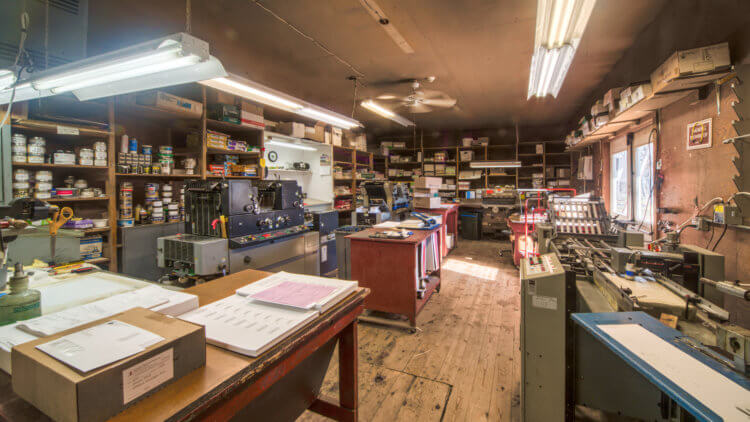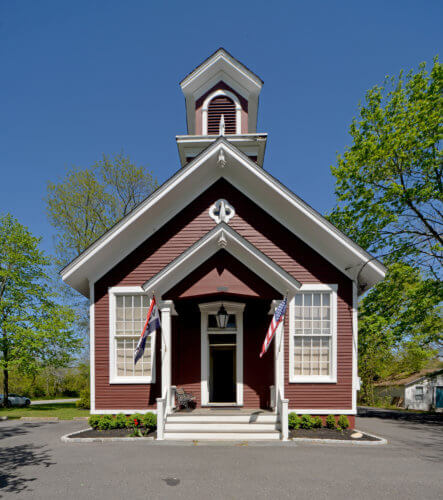Off Main Road in Southold is Horton’s Lane, a residential street that holds the small-town feel of the North Fork, even as it has grown busier and more popular in recent years.
South of the train tracks, at the corner of Traveler Street, sits a red building, easily mistaken for a church — but look closely. “It’s a four-gabled cupola. That’s not a steeple,” explains Mike Hagerman, the building’s owner. “It’s more indicative of academia.”
Built in 1867, it was originally a one-room schoolhouse. The sign out front today reads: “The Academy Printing.”
The name honors the building’s past, as “an academy devoted to higher learning that was funded by private tuition-paying students and built by a group of local citizens committed to being educated,” says Andrea Aurichio of AurichioSmith Real Estate. She has the exclusive listing on the building, at 360 Horton’s Lane, within the Southold Town Historic District.

The 4,000-square-foot building is asking $1.295 million. The building falls into mixed-use zoning as it serves both commercial and residential needs and could be used either as single or a mixed-family use, according to Aurichio.
About 20 years ago, owner Hagerman got the building listed on the National Register of Historic Places, which means the building’s exterior must be preserved. It has been the home of Academy Printing since 1948, a commercial print shop that prints everything from business cards to mailers.
Hagerman, a 12th-generation Southold Town resident, and his wife, Rita Hagerman, are the fourth owners of the business. They also are behind Peconic Bay Shopper where, in 2016, they published a history of the school and the building’s significance in Southold history.

The first Southold Academy opened elsewhere in 1835, when William D. Cochran, a “preeminent builder” at the time built a schoolhouse on Main Road in Southold. It closed in 1851.
The Rev. Dr. Epher Whitaker had the idea to reopen The Academy, and he went to his friend Henry Huntting, treasurer of both the Presbyterian Church and Southold Savings Bank, described in the article as “a man always ready to further good causes.” Huntting pledged $1,000 if another $5,000 could be raised — no small amount of money at the time.
The community supported the idea and a matching $1,000 donation followed, as well as pledges in various amounts from Southold and Peconic residents to make up the total amount needed.

In the summer of 1867, a lot was selected for the new Southold Academy on the east side of Horton’s Lane. Barnabas H. Booth supervised the construction of the building, which was “kept simple as funds were not plentiful,” the history says.
“The original plan did not include a steeple but N. Hubbard Cleveland ‘could not reconcile himself to this omission, and took up a special collection, that a steeple might be added,’” the history continues.
“The building’s steep steps and quaint steeple created a distinct and well-known landmark for many residents of the North Fork,” it says.
Its Cottage Red color makes it stand out too. While some of the older pictures make it appear white, Hagerman is certain it’s always been red. “In my youth, I painted it once and we sanded it down and it was red.”

Furniture was made specifically for the school with the desks and settees being “cherry on iron standards.” The Rev. Whitaker chose textbooks. He reached out to Hamilton College and a student, Elbert Wilmont Cumings, a 20-year-old only halfway through his college education, was tapped as the principal. While he returned to Hamilton two years later to graduate in 1871, several more Hamilton undergraduates followed.
“The reputation gained by the Southold Academy has placed it amongst the first institutions in that part of the state,” the Hamilton Literary Monthly wrote in January 1876.
The Whitaker Historical Collection at the Southold Free Library has lists of pupils, teachers and principals. Asked if there are any other remnants of the school, Hagerman remembers one discovery: “Years ago, a friend of mine, on a Saturday afternoon, decided to go crawling underneath it,” he says of the crawl space under the building. “We crawled around the spiders and found 21 ink wells,” he says. He gave most of them to his mother as keepsakes.

In 1907, the Academy became a business school. A course pamphlet from 1926 shows typewriting, penmanship, bookkeeping and even business law being offered. The school closed in 1939.
Hagerman says that in the 1930s, some famous actors used the space to rehearse for shows at Belmont Hall, Southold’s Lyceum. Walter Matthau, Jack Warden and Anne Meara, all part of the Southold Players, practiced in the empty schoolhouse.
The Boy Scouts used it as a headquarters in 1943. In 1949, Jim Smiley bought the building and started Academy Printing Enterprises, Inc.
In the 1970s, Kenneth Hagerman, Mike’s father, bought the building and the business after being employed there for 21 years, according to Mike Hagerman. He amended the name to Academy Printing Services.
“Horton’s Lane hasn’t changed all that much,” says Hagerman. “There is a new Methodist Church. Many of the homes have been renovated, are well kept.” The Academy building is convenient to Southold Town Hall, the Post Office, banks, restaurants and shopping. The property is ideal for a commercial business, whether as an office, retail space, art gallery or more, according to the broker. There is also ample onsite parking.
“It’s a nice community. Everybody seems to know each other like any other small town,” Hagerman says.

He believes the Academy means a lot to the community. “We keep it as nicely as we can. So many people will stop and take pictures,” he says. “I’ve actually worked here for 54 years. It’s part of my family. It’s going to be hard to let it go.”
He believes there is a buyer for the building who appreciates its history. “I think he or she will be local,” he says. When he retires, he plans to give the business to his employees. “I would like to see the business stay right where it is. The name and the logo.”
“One of the things that struck me about this building,” says broker Aurichio, “when I read the info that Rita Hagerman had given me, was a few remarks that were attributed to the local builder and the local architect who designed and built The Academy. They said they wanted to create a building that was warm in winter, cool in summer and had an abundance of light and fresh air,” she says. “The building still has all the original 13-foot tall windows.”
Aurichio knows a thing or two about what she calls “vintage historical buildings,” not just as a resident of the North Fork for more than 60 years and a broker since 1996, but from watching her parents restore a similar building, the former Greenport Auditorium/Goldin Furniture Company building that her brother still owns.
“It is interesting to see that vintage historical buildings like The Academy, and the Auditorium, have survived dating back to a time when no one really cared about landmarks and no one [was] talking about antique buildings,” she says. “They were considered old and ready to be demolished — white elephants that no one wanted. In the case of my mother’s building, she was able to take over a business and run it successfully and also put a law office upstairs for my father.”
“In the case of The Academy,” says Aurichio, “the one-room schoolhouse provided an ideal, functional and conveniently located place for a long-standing, local printing business. The Academy, Academy Printing and its current owners are an integral part of the Southold Town community.”
This article appeared in the Memorial Day 2022 issue of Behind The Hedges. Read the full digital version of the magazine here. Read more features from our magazine here.




















